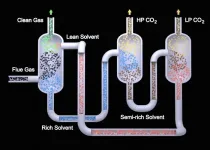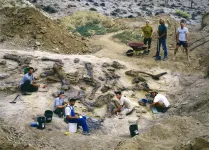(Press-News.org) Insights into how bacterial proteins work as a network to take control of our cells could help predict infection outcomes and develop new treatments.
Much like a hacker seizes control of a company's software to cause chaos, disease-causing bacteria, such as E. coli and Salmonella, use miniature molecular syringes to inject their own chaos-inducing agents (called effectors) into the cells that keep our guts healthy.
These effectors take control of our cells, overwhelming their defences and blocking key immune responses, allowing the infection to take hold.
Previously, studies have investigated single effectors. Now a team led by scientists at Imperial College London and The Institute of Cancer Research, London, and including researchers from the UK, Spain and Israel, has studied whole sets of effectors in different combinations.
The study, published today in Science, investigated data from experiments in mice infected with the mouse version of E. coli, called Citrobacter rodentium, which injects 31 effectors.
The results show how effectors work together as a network, allowing them to colonise their hosts even if some effectors are removed. The investigation also revealed how the host's immune system can bypass the obstacles the effectors create, triggering complementary immune responses.
The researchers suggest that knowing how the makeup of effector networks influences the ability of infections to take hold could help design interventions that disrupt their effects.
Study lead Professor Gad Frankel, from the Department of Life Sciences at Imperial, said: "The data represent a breakthrough in our understanding of the mechanisms of bacterial infections and host responses. Our results show that the injected effectors are not working individually, but instead as a pack.
"We found there is an inherent strength and flexibility to the network, which ensures that if one or several components don't work, the infection can go on. Importantly, this work has also revealed that our cells have a built-in firewall, which means that we can deal with the hacker's corruptive networks and mount effective immune responses that can clear the infection."
Study co-lead Professor Jyoti Choudhary, from the Functional Proteomics Lab at The Institute of Cancer Research, London, said: "Our study shows that we can predict how a cell will respond when attacked by different combinations of bacterial effector proteins. The research will help us to better understand how cells, the immune system and bacteria interact, and we can apply this knowledge to diseases like cancer and inflammatory bowel disease where bacteria in the gut play an important role.
"We hope, through further study, to build on this knowledge and work out exactly how these effector proteins function, and how they work together to disrupt host cells. In future, this enhanced understanding could lead to the development of new treatments."
During their experiments, the team were able to remove different effectors when infecting mice with the pathogen, tracking how successful each infection was. This showed that the effector network produced by the pathogen could be reduced by up to 60 percent and still produce a successful infection.
The team collected data on more than 100 different synthetic combinations of the 31 effectors, which Professor Alfonso Rodríguez-Patón and Elena Núñez-Berrueco at the Universidad Politécnica de Madrid used to build an artificial intelligence (AI) algorithm.
The AI model was able to predict the outcomes of infection with Citrobacter rodentium expressing different effector networks, which were tested with experiments in mice. As it is impossible to test in the lab all the possible networks that 31 effectors can form, employing an AI model is the only practical approach to studying biological systems of this complexity.
Co-first author Dr David Ruano-Gallego from the Department of Life Sciences at Imperial, said: "The AI allows us to focus on creating the most relevant combinations of effectors and learn from them how bacteria are counteracted by our immune system. These combinations would not be obvious from our experimental results alone, opening up the possibility of using AI to predict infection outcomes."
Co-first author Dr Julia Sánchez-Garrido, from the Department of Life Sciences at Imperial, added: "Our results also mean that in the future, using AI and synthetic biology, we should be able to work out which cell functions are essential during infection, enabling us to find ways to fight the infection not by killing the pathogen with antibiotics, but instead by changing and improving our natural defence responses to infection."
INFORMATION:
This project was supported by The Wellcome Trust.
A team led by Christoph Utschick and Prof. Rudolf Gross, physicists at the Technical University of Munich (TUM), has developed a coil with superconducting wires capable of transmitting power in the range of more than five kilowatts contactless and with only small losses. The wide field of conceivable applications include autonomous industrial robots, medical equipment, vehicles and even aircraft.
Contactless power transmission has already established itself as a key technology when it comes to charging small devices such as mobile telephones and electric toothbrushes. Users would also like to see contactless charging made available for larger electric machines such as industrial robots, medical equipment and electric vehicles.
Such devices could ...
How do you turn "dumb" headphones into smart ones? Rutgers engineers have invented a cheap and easy way by transforming headphones into sensors that can be plugged into smartphones, identify their users, monitor their heart rates and perform other services.
Their invention, called END ...
Irvine, Calif., March 11, 2021 - Catastrophic collapse of materials and structures is the inevitable consequence of a chain reaction of locally confined damage - from solid ceramics that snap after the development of a small crack to metal space trusses that give way after the warping of a single strut.
In a study published this week in Advanced Materials, engineers at the University of California, Irvine and the Georgia Institute of Technology describe the creation of a new class of mechanical metamaterials that delocalize deformations to prevent failure. They did so by turning to tensegrity, a century-old design principle in which isolated ...
LAWRENCE -- Much like coronavirus, circulating HIV-1 viruses mutate into diverse variants that pose challenges for scientists developing vaccines to protect people from HIV/AIDS.
"AIDS vaccine development has been a decades-long challenge partly because our immune systems have difficulty recognizing all the diverse variants of the rapidly mutating HIV virus, which is the cause of AIDS," said Brandon DeKosky, assistant professor of pharmaceutical chemistry and chemical & petroleum engineering at the University of Kansas.
In the past five years, tremendous progress has been ...
Philadelphia, March 12, 2021 - Researchers from Children's Hospital of Philadelphia (CHOP) have determined what happens at a cellular level as the lung alveolus forms and allows newborns to breathe air. Understanding this process gives researchers a better sense of how to develop therapies and potentially regenerate this critical tissue in the event of injury. The findings were published online today by the journal Science.
The lung develops during both embryonic and postnatal stages, during which lung tissue forms and a variety of cell types perform specific roles. During the transition from embryo to newborn is when the alveolar region of the lung ...
Skoltech researchers were able to show that patterns that can cause neural networks to make mistakes in recognizing images are, in effect, akin to Turing patterns found all over the natural world. In the future, this result can be used to design defenses for pattern recognition systems currently vulnerable to attacks. The paper, available as an arXiv preprint, was presented at the 35th AAAI Conference on Artificial Intelligence (AAAI-21).
Deep neural networks, smart and adept at image recognition and classification as they already are, can still be vulnerable ...
An enzyme called MARK2 has been identified as a key stress-response switch in cells in a study by researchers at Johns Hopkins Bloomberg School of Public Health. Overactivation of this type of stress response is a possible cause of injury to brain cells in neurodegenerative diseases such as Alzheimer's, Parkinson's, and Amyotrophic Lateral Sclerosis. The discovery will make MARK2 a focus of investigation for its possible role in these diseases, and may ultimately be a target for neurodegenerative disease treatments.
In addition to its potential relevance to neurodegenerative diseases, the finding is an advance in understanding basic cell biology.
The paper describing ...
RICHLAND, Wash.--As part of a marathon research effort to lower the cost of carbon capture, chemists have now demonstrated a method to seize carbon dioxide (CO2) that reduces costs by 19 percent compared to current commercial technology. The new technology requires 17 percent less energy to accomplish the same task as its commercial counterparts, surpassing barriers that have kept other forms of carbon capture from widespread industrial use. And it can be easily applied in existing capture systems.
In a study published in the March 2021 edition of International Journal of Greenhouse Gas Control, researchers from the U.S. Department of Energy's Pacific Northwest National Laboratory--along with collaborators from ...
MADISON, Wis. -- Mexican wolves in the American Southwest disappeared more quickly during periods of relaxed legal protections, almost certainly succumbing to poaching, according to new research published Wednesday.
Scientists from the University of Wisconsin-Madison found that Mexican wolves were 121% more likely to disappear -- despite high levels of monitoring through radio collars -- when legal rulings permitted easier lethal and non-lethal removal of the protected wolves between 1998 and 2016. The disappearances were not due to legal removal, the researchers say, but instead were likely caused by poachers hiding evidence of their activities.
The findings suggest that consistently strong protections for endangered predators lead ...
Fossil sites sometimes resemble a living room table on which half a dozen different jigsaw puzzles have been dumped: It is often difficult to say which bone belongs to which animal. Together with colleagues from Switzerland, researchers from the University of Bonn have now presented a method that allows a more certain answer to this question. Their results are published in the journal Palaeontologia Electronica.
Fossilized dinosaur bones are relatively rare. But if any are found, it is often in large quantities. "Many sites contain the remains of dozens of animals," explains Prof. Dr. Martin Sander from the Institute ...





